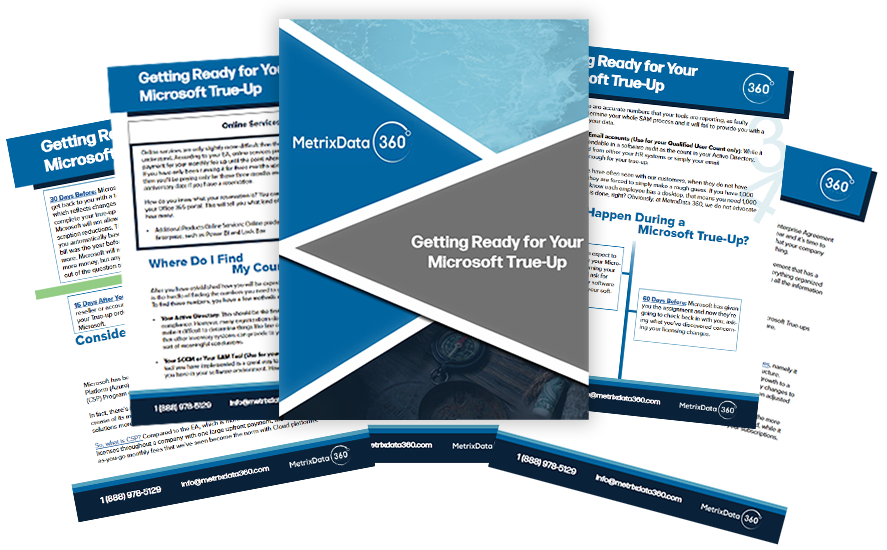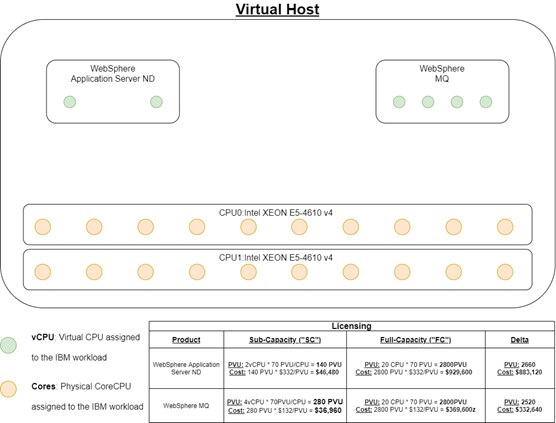Tricks for your Microsoft EA True Up
If you have an Enterprise Agreement (EA) with Microsoft, then you are probably familiar with the EA’s annual True-Up. It’s a straightforward way of condensing a year’s worth of headaches and frustrations around purchasing software licenses into a short period of only 90 days (although hopefully, you’re preparing earlier than that!).
Since these true ups amount to such a large investment for enterprises, it is important that you remain in control of the situation and know what you can and can’t do. Often companies can feel trapped or chained to their chairs in these agreements but with MetrixData 360, we have helped many clients truly harness the potential of their EA. We’ve helped our enterprise clients cut down wastage in their EAs (sometimes hundreds of thousands of dollars have been removed from EA agreements), and we know how to dance this dance with Microsoft.
So in this blog post, we will share some tricks from our experts.
And don’t forget. At any point in reading this article, you would like some further explanation, check out our downloadable EA True Up Guide below:

Tricks for your Microsoft EA True Up
If you have an Enterprise Agreement (EA) with Microsoft, then you are probably familiar with the EA’s annual True-Up. It’s a straightforward way of condensing a year’s worth of headaches and frustrations around purchasing software licenses into a short period of only 90 days (although hopefully, you’re preparing earlier than that!).
Since these true ups amount to such a large investment for enterprises, it is important that you remain in control of the situation and know what you can and can’t do. Often companies can feel trapped or chained to their chairs in these agreements but with MetrixData 360, we have helped many clients truly harness the potential of their EA. We’ve helped our enterprise clients cut down wastage in their EAs (sometimes hundreds of thousands of dollars have been removed from EA agreements), and we know how to dance this dance with Microsoft.
So in this blog post, we will share some tricks from our experts.
And don’t forget. At any point in reading this article, you would like some further explanation, check out our downloadable EA True Up guide below:
You Don’t Need to Fill Out Every True-Up Form that Comes Your Way
If you have a reseller supporting you with your EA, then you may receive True-Up forms quite frequently — some of our clients report that they receive them on a monthly basis. You might feel compelled to fill each one of them out, either because your reseller encourages you to do so, and they know best, or because you’d rather not go up against Microsoft. However, unlike your annual True-Up, which will require a mandatory Update Statement (even if you haven’t added to your counts this year), these monthly True-Up forms are completely optional features that you don’t have to fill out.
You Can True-Down to your Original Count…Or Zero!
If this is not your first True-Up, you likely noticed that adding counts to your EA is easy – encouraged even – however, it can be very difficult to true-down or reduce your counts in any way. While it may be difficult, it is not impossible if you are following these steps:
Know Your Data
The first step of Truing-Down is to know what you are truing down to.
There are many ways to check your counts:
- in your Active Directory;
- in your SCCM or your SAM Tool (only useful if you’re trying to find your Qualified Device Count); or
- in your HR Systems and Email Accounts (only useful for finding your Qualified User Counts).
You can also guess based on your number of employees, but while this is something most companies are forced to resort to, this is not something MetrixData 360 advises.
Create a Value Gap
Knowing your data will also allow you to create a Value Gap, and build your argument for truing down based upon cold, hard data. At MetrixData 360, we have built our tools for this task, which can significantly cut down your workload and your guessing.
Start Preparing for Your Microsoft EA True Up Early
You can True-Up pretty much up to the last second, but if you want to True Down, you will have to be prepared well ahead of time and adhere to the deadlines outlined in your agreement. Microsoft will only let you reduce your counts up until 30 days before your True-Up date, so you will have to be ready with your data and your arguments for Truing Down long before then.
Check Your Original Counts
When you are trying to reduce your counts in your EA, there are two things that really prove to be determining factors on how low you can go: if the product is an enterprise-wide purchase and if it is a subscription or a perpetual license.
If you have an enterprise-wide purchase, the only way Microsoft will allow you to reduce your counts is by scaling back online service subscriptions down to their original number that you started with. For example, if your original EA asked for 500 subscriptions and the following year you grew to 1,000, the lowest you can reduce your count to is 500. However, if your purchase is not enterprise-wide, it is possible to reduce the counts, so long as the minimum requirements are maintained.
Check Additional Products that are Available as Subscription Licenses
There are a few different products which are included in the EA, such as Enterprise Products, Enterprise Online Services, Additional Products, Additional Products Online Services. Additional Products that have subscriptions can be reduced to a count of zero! We’ve pulled such a move before at MetrixData 360, which resulted in our client saving $800,000!
Watch Out for Complicated Products
While Microsoft may have products that are easy to use, there are, of course, the challenging ones that are difficult to wrap your head around, let alone manage. Make sure to pay close attention to your deployment data around these products, ensuring that you have a strong understanding of your contract’s language and deployment data. Some of Microsoft’s more complicated products include:
- SQL Servers
- Office 365
At MetrixData 360, we put extensive effort into understanding both products and have a wide collection of material to read and tools to assist you in gaining a strong handle on these two products in your software environment.
Need Help Getting Ready for Your True-Up?
With your True-Up approaching, it’s important to have a few tricks up your sleeve. Closing such deals could mean the difference between optimizing your spending and spending copious amounts of money that you don’t need to.
The Microsoft reps may be nice, but there is only so much that they will be willing to help you save when their job is to make sure you do exactly the opposite. That is why you need someone who can support you and have your back during this engagement.
MetrixData 360 is here for you. We have many Fortune 500 customers who we have helped to minimize the impact of their EA on their software budget.
If you would like to learn more about getting ready for your Microsoft True-Up, you can download our free booklet, Preparing for a Microsoft True-Up.













